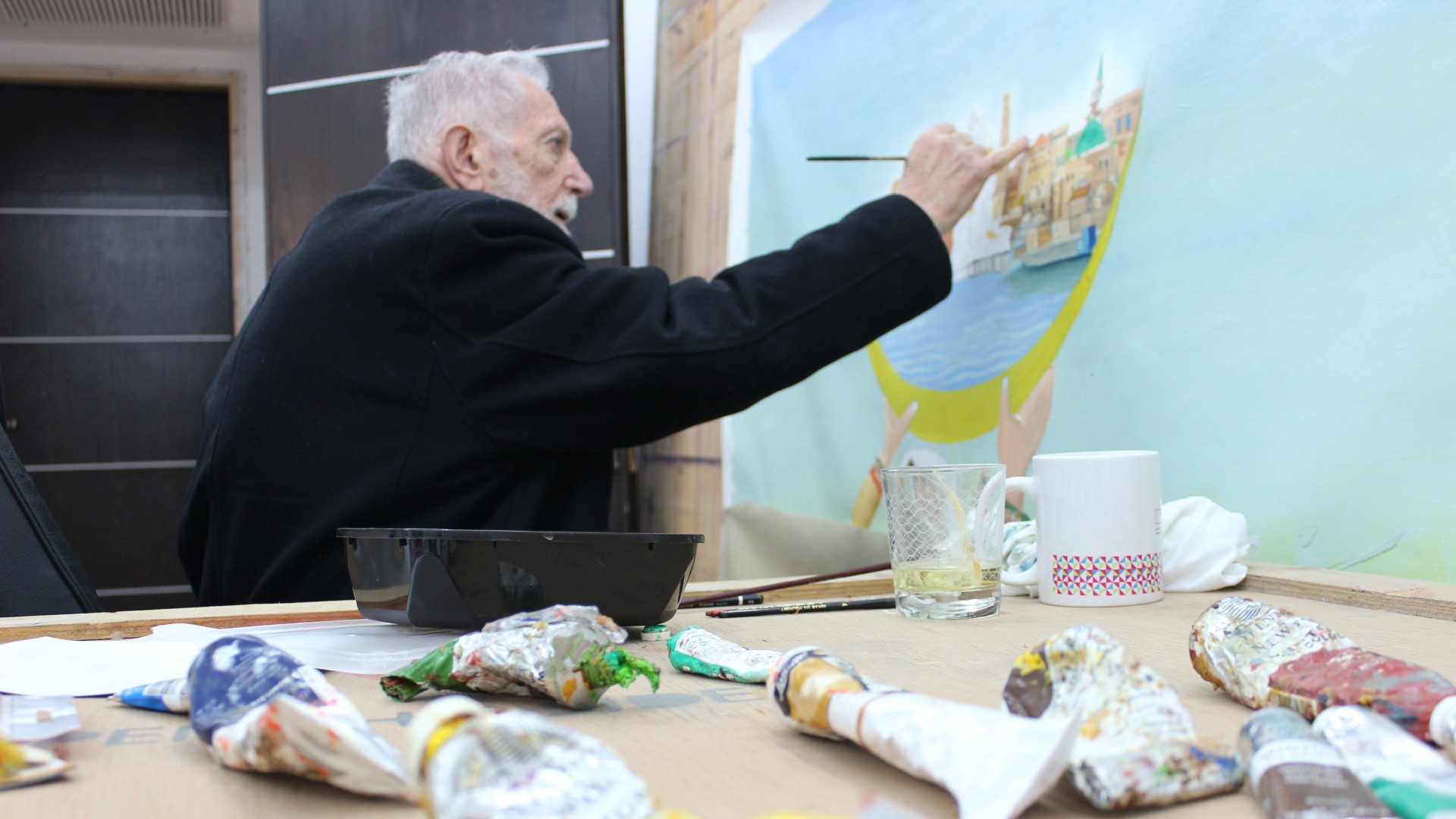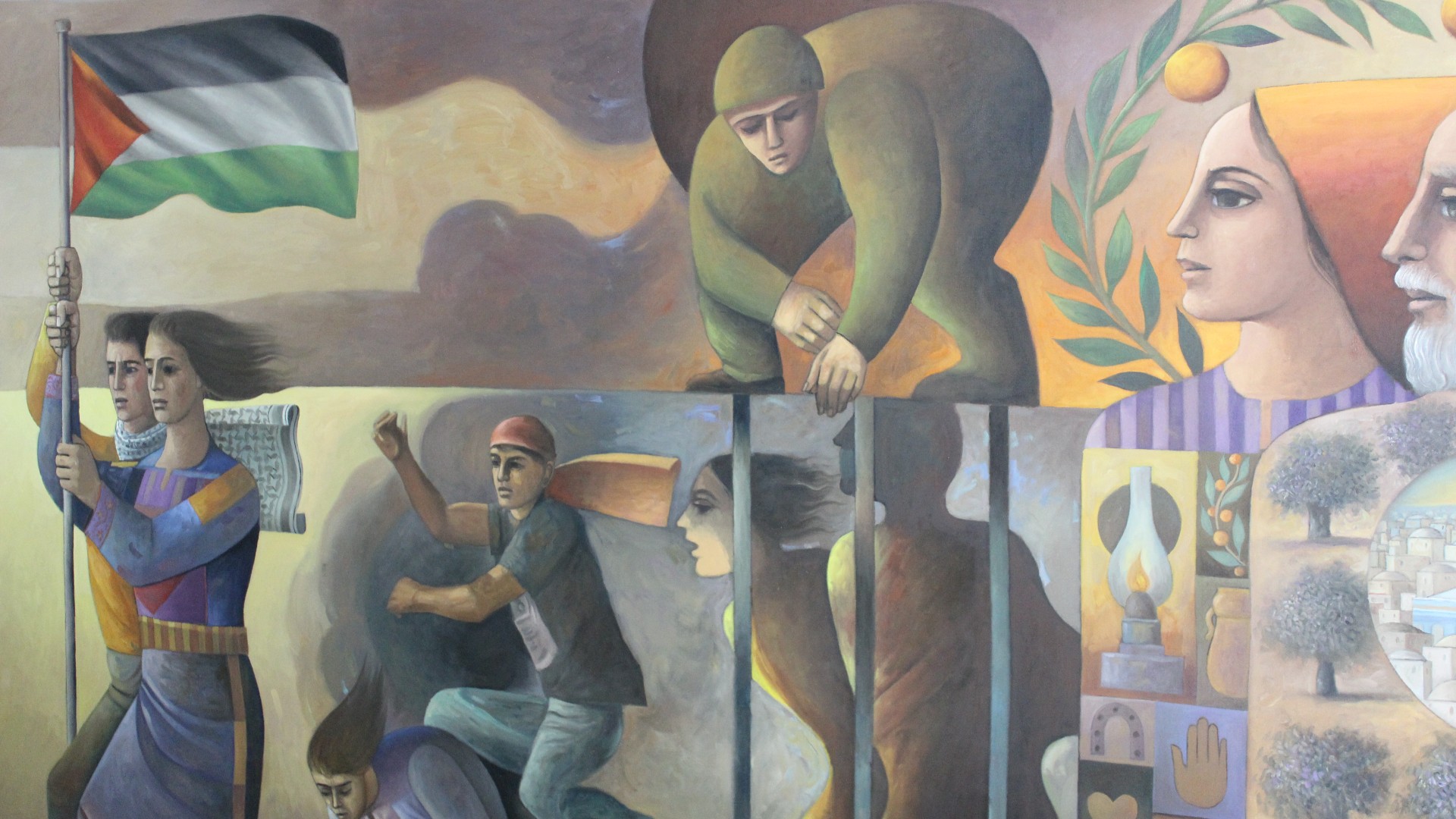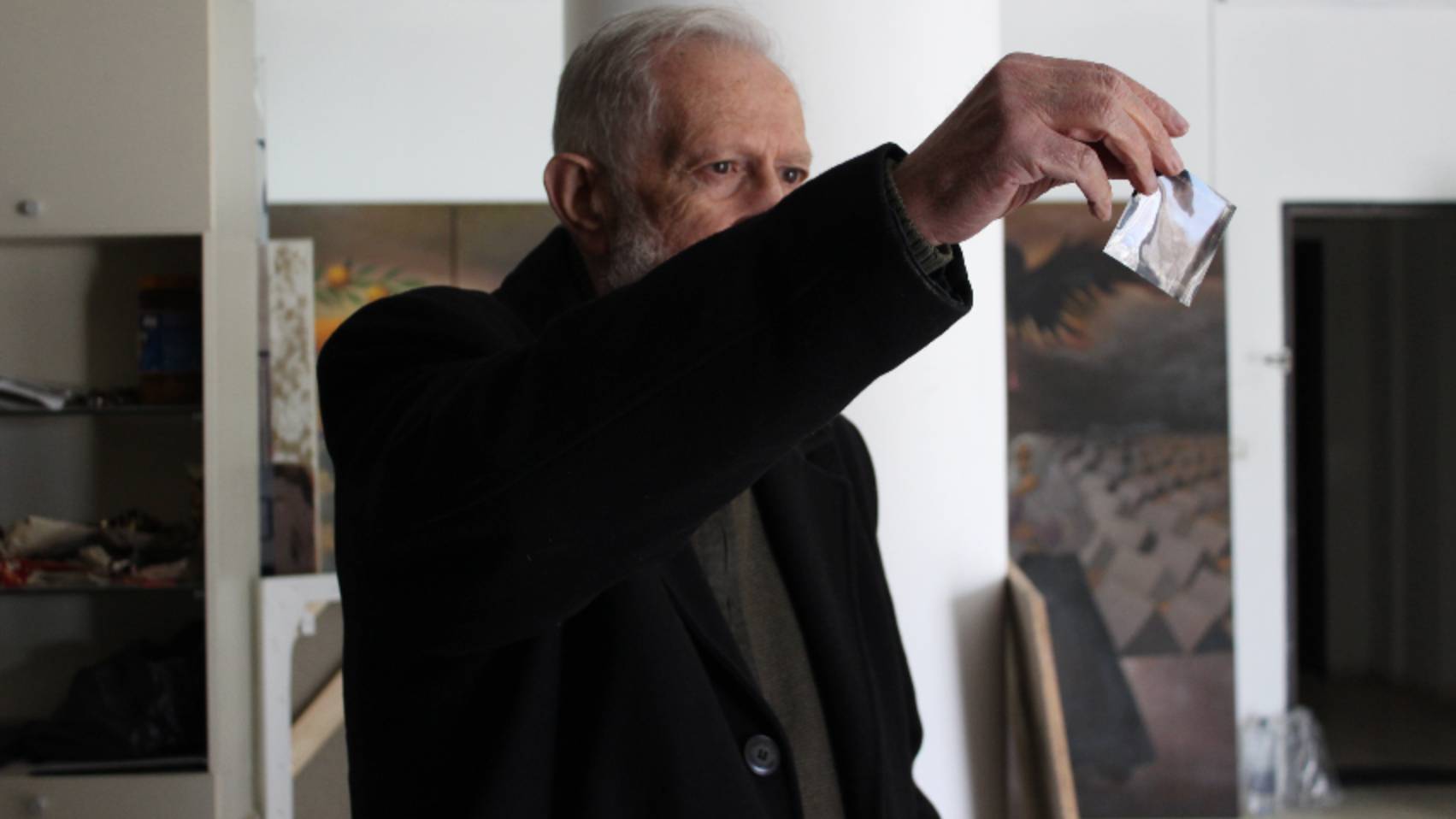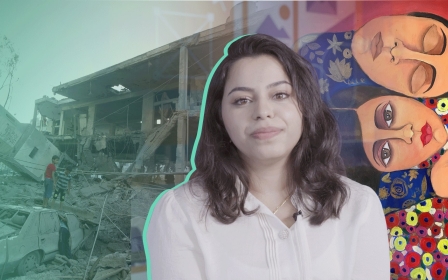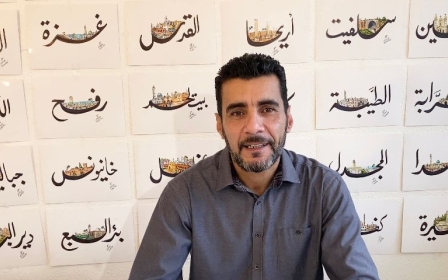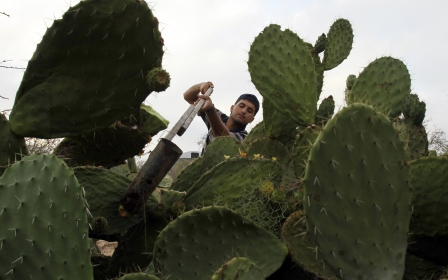The symbol as resistance: Sliman Mansour on occupation and Palestinian identity
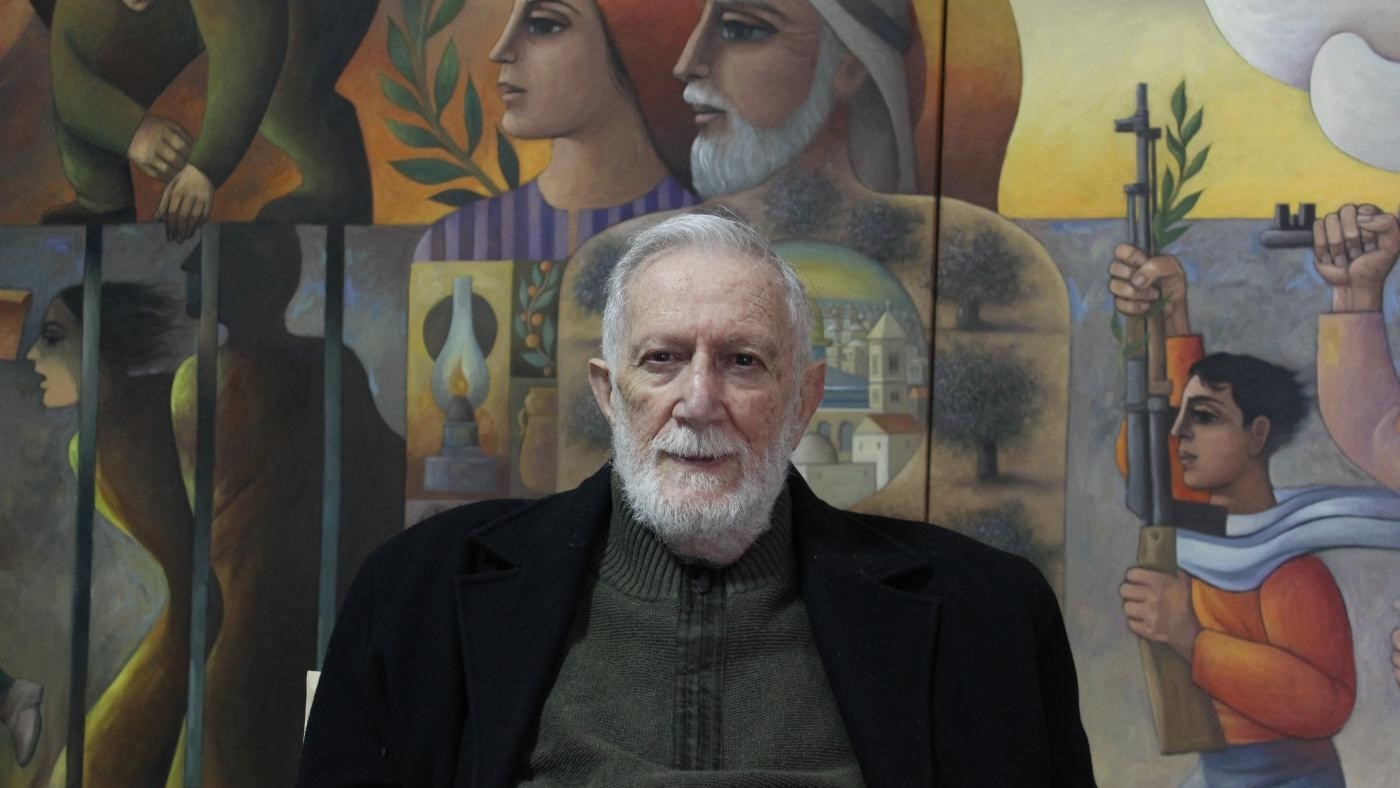
Sliman Mansour's studio in Ramallah fits the stereotypical image of an artist's creative space: messy, with pens, paintbrushes and photos sprawled across the table alongside half-finished cups of tea and cigarette butts.
The walls of the workspace are lined with his own paintings, as well as canvases gifted to him by fellow artists.
Over the course of his career, Mansour's work has become internationally renowned for his figurative and symbolic pieces, which capture the social and cultural realities of Palestinian life under Israeli occupation.
One of his most famous paintings is his 1994 work, Last Summer in Palestine, which is his interpretation of Leonardo Da Vinci's The Last Supper, except the image of Jesus is replaced by a Palestinian man and 12 Palestinian women take the place of the disciples.
Another famous work is 2005's Camel of Burdens, which shows a frail Palestinian elder carrying an eye shaped sphere on his back and within it is the city of Jerusalem.
His collected works draw on common Palestinian motifs, including the olive tree, which is a symbol of the deeply rooted connection Palestinians have with the land.
"I remember when I was 12, my grandfather bought a piece of land. He didn't measure it with dunams or acres, he would say I bought 53 olive trees," Mansour tells Middle East Eye, highlighting the significance of the crop in his own upbringing.
The artist's own life is inextricable from the symbols he puts down in his paintings and the realities of occupation.
Mansour lives in Jerusalem but runs his studio in Ramallah in the occupied West Bank, making the journey across Israeli checkpoints several times a week.
That trip can take anywhere from 45 minutes to six hours, he tells MEE.
The occupation and art
Mansour was born in Birzeit, a Palestinian town north of Ramallah, in 1947, a year before the Nakba, which saw more than 700,000 Palestinians forcibly expelled from their homes to make way for the creation of Israel.
The young artist took to drawing from a very young age and later a German tutor at a boarding school in Bethlehem noticed his talent, encouraging the young Mansour to delve deeper into painting and entering his work into art contests.
"He applied for my work to be a part of a drawing club and then told me that I had won a competition for the United Nations Children of the World. That was in 1962," Mansour recalls.
For his efforts, the teenage Mansour won a $200 cash prize but more importantly, he came to the realisation that he would like to pursue art in a more serious way.
The 1960s were a period in which a strong sense of national identity was taking form among both Palestinians and Israelis.
The Israeli self-narrative during this period was one which largely erased the Palestinian presence on the land of historic Palestine prior to Zionist migrations of the early 20th century.
It was a period in which there was a heavy emphasis on inaccurate tropes, such as the idea that modern Jewish settlers in the region had encountered a barren and sparsely populated land; that they had made the desert bloom.
There was no room for a native Palestinian community in such myth-making.
According to Mansour, Palestinians during this period faced the risk of having their historical narrative disappear completely at the expense of such Zionist ideas.
"That was the very strategy of the Zionist movement, to deny your existence, because when you are not there, it's much easier to take your land, to kill you, to imprison you," he says.
'Anything that made Israel angry later became a symbol'
- Sliman Mansour, artist
It became incumbent, therefore, on artists like Mansour to restate the Palestinian story by incorporating traditional symbols, as well as new ones, into their art.
"As artists, we started to search for images to reflect identity," he explains, clarifying that this was a process that involved referring to ancient culture and the landscape of historic Palestine.
"The landscape is artwork by our ancestors. When the Israelis occupied our land they started planting [non-native] cypress and pine trees instead of olive trees to change the landscape," he says.
The symbol as resistance
Besides the olive tree, Mansour's work features a number of other symbols that are associated with the Palestinian struggle, such as the Jaffa orange, thobes embroidered in the traditional tatreez style, the dove and the keffiyeh scarf.
"When I paint orange trees I am painting land that was occupied in 1948, and when I paint olive trees, I am painting about land that was occupied in 1967," he says referring to the Nakba, as well as the later Israeli conquest of the West Bank, East Jerusalem and Gaza.
Another more recent symbol, according to Mansour, is the cactus plant, which he says has become associated with Palestinian resistance and struggle.
"If you wanted to know if there was once a village, you would look out for the cactus plants. They don't die easily," he says.
The curation of a network of symbols, which reinforces Palestinian identity and arguably helps keep it alive, has ruffled feathers within Israel.
In the most recent and infamous example of Israeli repression of Palestinian symbols, Israeli lawmakers have been pushing for a ban on the Palestinian flag, including it among flags of a "hostile entity".
Mansour says his work has been targeted for decades.
"In 1979 when we had started doing exhibitions, the Israelis would come and confiscate paintings that they didn't like," he says, adding: "I would watch what they would take, and it was silly things, like a peasant woman wearing nice embroidery and working in the field."
The justification offered by the Israelis to Mansour and other artists was that the images constituted "incitement". For the artists themselves, the idea of a Palestinian woman tending to her land directly undermines Israel's founding myth of Zionist pioneers turning desert to farmland.
Mansour also says that Israeli officials have visited Mansour's exhibitions in the past and closed them down, taking the keys to the gallery hosting his work with them.
"They would meet with us and discuss the art we should do, telling us to paint nice flowers or nice women instead of political art."
If stifling Palestinian activism through art was the intention, it was an aim that thoroughly backfired.
"Anything that made Israel angry later became a symbol," Mansour explains, describing how Israel's reaction forced artists to take on more subtle symbols of Palestinian identity.
One such example is the watermelon, which became associated with Palestine by virtue of it sharing the colours of the Palestinian flag.
The Palestinian artist
Over the decades, Mansour has amassed a dedicated following and gained international recognition for his work.
He was awarded the 2019 Unesco-Sharjah Prize for Arab Culture; he also received the grand prize at the Cairo Biennial in 1998 and the Palestine Prize for Visual Arts in 1998.
Today Mansour dedicates his time to mentoring young artists and students, providing them with the opportunity to nurture their creative abilities and benefit from his lifetime's experience.
As an artist, Mansour says he would rather steer clear of politics. But as a Palestinian, art is a way out; a way to appease a conscience that will not allow him to look away from the fact of occupation.
"I firmly believe in the significance of embracing your craft and embracing your connection to your people, their culture, and their pursuit of freedom," Mansour asserts. "It is crucial for my students to grasp the sense of belonging and never lose hope.
"If my art can persuade my people then it has the power to sway anyone else in the world," he explains.
"I believe I have made significant contributions to Palestinian art, not only through my own creations but also by assisting in the establishment of the Palestinian Artists League. I can say that I have a clear conscience."
Asked what he would paint if there were no occupation, Mansour responds: "I would paint flowers and captivating women."
This article is available in French on Middle East Eye French edition.
Middle East Eye propose une couverture et une analyse indépendantes et incomparables du Moyen-Orient, de l’Afrique du Nord et d’autres régions du monde. Pour en savoir plus sur la reprise de ce contenu et les frais qui s’appliquent, veuillez remplir ce formulaire [en anglais]. Pour en savoir plus sur MEE, cliquez ici [en anglais].



